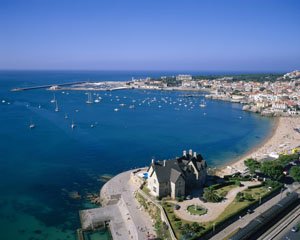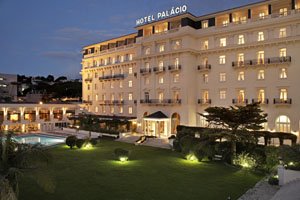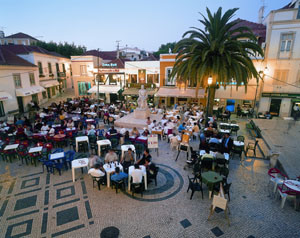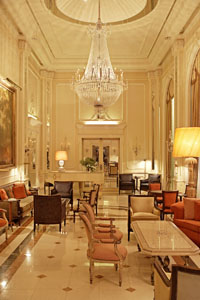The Portuguese Riviera
 Where Spain is famous for its Costas, the most privileged coastal settings of France, Italy and Portugal, amongst others, are called Rivieras. The very word is synonymous with a classic sense of opulence and style, and though the term originated centuries ago to describe the Ligurian coastlines of France and Spain, it is with the Belle Epoque of the late 19th century that Rivieras remain forever associated.
Where Spain is famous for its Costas, the most privileged coastal settings of France, Italy and Portugal, amongst others, are called Rivieras. The very word is synonymous with a classic sense of opulence and style, and though the term originated centuries ago to describe the Ligurian coastlines of France and Spain, it is with the Belle Epoque of the late 19th century that Rivieras remain forever associated.
The making of a Riviera
What sets a Riviera apart from a sunny coastal region popular with tourists is therefore a sense of classical elegance and pedigree. In the case of Portugal, it is the distinction between the Algarve, first ‘discovered’ by tourism in the 1960s, and the coastal resort towns of Cascais and Estoril, whose traditions stretch much further back. Situated close to Lisbon, where the Tejo River meets the Atlantic Ocean, the area began attracting sophisticates from Europe and beyond in the course of the 19th century, in much the same way as San Remo, Biarritz and Cannes were doing at the time.
By the end of the century Estoril had become the centre point of a Riviera that brought sandy beaches, leafy promenades, luxurious grand hotels and palatial mansions together under bright blue skies refreshed by gentle sea breezes. As such, it became a gathering point for the elite of the day, who would congregate at the stylish beachside cafes of Tamariz, shop in the then fishing village of Cascais and enjoy glamorous gala dinners and balls at the famous Palacio Hotel or within the Art Nouveau villas that populate the wooded hills of Monte Estoril.
 Portugal’s neutrality during the Second World War meant that Lisbon became the spy centre of Europe and Estoril was teeming with agents from both the Allied and Axis camps. One of the centres of diplomatic intrigue was the stylish Bar Estoril at the aptly named Palacio Hotel, where spies and double agents would meet and conspire. After the war, Estoril remained a preferred spot and the location chosen by the Spanish, Italian, Bulgarian and Romanian royals in exile. Spain’s King Juan Carlos spent most of his youth here before assuming his duties back home. Though the Algarve, like the Costas, has since surpassed the Portuguese Riviera as a tourist destination, Estoril and Cascais retain a sophisticated ambiance that favours quality over quantity.
Portugal’s neutrality during the Second World War meant that Lisbon became the spy centre of Europe and Estoril was teeming with agents from both the Allied and Axis camps. One of the centres of diplomatic intrigue was the stylish Bar Estoril at the aptly named Palacio Hotel, where spies and double agents would meet and conspire. After the war, Estoril remained a preferred spot and the location chosen by the Spanish, Italian, Bulgarian and Romanian royals in exile. Spain’s King Juan Carlos spent most of his youth here before assuming his duties back home. Though the Algarve, like the Costas, has since surpassed the Portuguese Riviera as a tourist destination, Estoril and Cascais retain a sophisticated ambiance that favours quality over quantity.
A spectacular setting
Interestingly enough, the coastal area around Estoril and Cascais was officially called the Costa do Sol, though it soon became better known as the Portuguese Riviera, or even the Costa de Estoril. Today it remains a popular destination for a combination of cultural and quality tourists, creating an interesting blend of up-market visitors and young trendies who rub shoulders at quaint seaside cafes and restaurants. During the day the high-end tourists play a round of golf or relax beside the pool of a beach club or luxury hotel, while the younger set populate the beaches and stroll through the old streets of Cascais, a stylish town that has outgrown its fishing village origins to almost equal Estoril in grandeur.
 Nightfall sees the former group frequent the many fine restaurants as their youthful counterparts prepare for the social scene at trendy nightclubs or the chill out venues at the Cascais marina. The fact that this is more than just a tourist destination is reflected in a highly diverse foreign community made up largely of professionals that work in Lisbon but choose to live here. Estoril-Cascais is, in fact, the preferred residence of many of Lisbon’s executive professionals, and with the Portuguese capital just a half hour removed from this beautiful enclave it is an easy choice to make.
Nightfall sees the former group frequent the many fine restaurants as their youthful counterparts prepare for the social scene at trendy nightclubs or the chill out venues at the Cascais marina. The fact that this is more than just a tourist destination is reflected in a highly diverse foreign community made up largely of professionals that work in Lisbon but choose to live here. Estoril-Cascais is, in fact, the preferred residence of many of Lisbon’s executive professionals, and with the Portuguese capital just a half hour removed from this beautiful enclave it is an easy choice to make.
If the ‘Riviera’ provides a stylish and peaceful respite from the hectic bustle of a major city, then the reverse is also true, for the proximity of Lisbon and its large historic centre offers a bountiful choice of museums, sights and experiences to savour. Among them are the Baixa, a stylish business and shopping district at the geographical heart of the city, from which the densely packed traditional district of Alfama, the grand Avenida da Liberdade and the genteel charm of Chiado and Bairro Alto fan out across the hills. Ever present is the mighty Tejo River, which marks the present of this city as strongly as it has traced it past, carving a broad blue path between dominant hillsides that give Lisbon and its beautiful estuary one of the most spectacularly scenic settings of any capital in Europe.
The Golden Gate style bridge that spans the river forms an iconic part of this panorama, along with the towering statue of Christ the Redeemer, the Tower of Belem and the Monument to the Discoveries, all of which immediately identify this as Lisbon. When crossing the river from high up, the bridge opens up unforgettable views back to the city and the river all the way to the sea.
Changing scenery
When you’ve enjoyed the charming cafes, quiet squares, historic buildings and antique yellow trams of Lisbon and have walked along the beautiful riverside parks and monuments of Belem, some five minutes west of Lisbon’s centre, the drive or train ride back to Cascais and Estoril takes no more than half an hour. What’s more, the route winds along the northern shore of the Tejo, following the river as it broadens en route to its meeting with the Atlantic.
Along the way you pass a succession of pretty coastal towns – Algés, Paço de Arcos, Oeiras – that effectively connect Estoril to Lisbon. Looking across the water you will see the green cliffs that form the southern shore of the Tejo. Dotted with the occasional fishing village popular for its seafood restaurants, this shoreline suddenly recedes as the river greets the ocean. After you round the little cape at Torre, the string of beaches that line the trip from Lisbon to Estoril begin to front the Atlantic, not the Tejo.
 The last stretch takes in Parede and Carcavelos before you reach the unmistakable landmarks of Estoril, or the end of the railway line at neighbouring Cascais. From here, a coastal road follows the increasingly wild shoreline westwards to Cabo da Roca – the westernmost point on the European continent – passing through the luxurious residential areas of Guia and Quinta da Marinha on the edge of Cascais before emerging into a protected landscape of coastal scrubland, pine groves and coves that suddenly opens out into an expansive beach called Guincho. Reminiscent of the Valdevaqueros Beach in Tarifa, it also resembles the groovy Andalusian destination in being one of the leading surfing and kite-surfing venues in Europe.
The last stretch takes in Parede and Carcavelos before you reach the unmistakable landmarks of Estoril, or the end of the railway line at neighbouring Cascais. From here, a coastal road follows the increasingly wild shoreline westwards to Cabo da Roca – the westernmost point on the European continent – passing through the luxurious residential areas of Guia and Quinta da Marinha on the edge of Cascais before emerging into a protected landscape of coastal scrubland, pine groves and coves that suddenly opens out into an expansive beach called Guincho. Reminiscent of the Valdevaqueros Beach in Tarifa, it also resembles the groovy Andalusian destination in being one of the leading surfing and kite-surfing venues in Europe.
The road is popular with sightseers, the cycling paths with fitness fanatics, the coves with sunbathers seeking seclusion and the cliffs draw both anglers precariously balanced on its rocky outcrops and romantic souls who peer into the wide expanse of sea and sky. The abundance of these waters has endowed Portuguese cuisine with a rich array of fish and seafood dishes that are celebrated at the renowned restaurants and beach clubs that dot this stretch of coast. At Guincho, meanwhile, the atmosphere is altogether more hippy, as surfers emerge from VW camper vans to take on the powerful waves breaking on the fine white sand of this enormous fan-shaped beach.
The beach sprawls into dunes that eventually turn into pine forests ascending the foothills of the Serra de Sintra mountain range. Pass the pretty picnic spots and you come to the village of Malveira da Serra, where left takes you upwards and past quaint villages en route to Cabo da Roca, the impressive windswept western point of the continent. A little north of here are some fantastic expanses of beach, but if you’d turned right at Malveira da Serra you would have entered into the thick forest at the base of the Serra de Sintra mountain range. This part of the large Parque Natural Sintra-Cascais passes Penha Longa, a luxurious golf resort surrounding a monastery now converted into a five-star hotel, before emerging between the Estoril racing circuit – former home of the Portuguese Grand Prix – and the beautiful mountain town of Sintra.
A privileged enclave
Turn south at the circuit and you will have completed a trajectory that brings you back to the leafy villa suburbs of Estoril, an indication of just how much variety is packed into this relatively small area. A Riviera of this kind is, of course, not complete without good golf facilities, and beside the renowned Penha Longa golf course, which winds its way through the scenery of a natural park, there are the courses of Quinta da Marinha, Oitavos, Quinta da Beloura and the famous Estoril Golf Club, first opened in 1929 and linked with the glamorous Palacio Hotel.
Add to this a choice of first-class tennis clubs and riding schools, such as the Clube de Tenis Estoril and the Hipodromo da Quinta da Marinha, hiking and mountain climbing in the Serra de Sintra, the nearby aerodrome at Tires and the myriad of water sports and sailing activities at the Cascais marina, and it becomes clear that this exclusive resort area packs quite a punch in the sports department. Lovers of art and culture will similarly not be dependent on Lisbon, as the area is not only home to a surprisingly rich cache of fortresses, palaces and museums, but also features an active street art scene that extends to regular open air exhibitions along the lively seaside promenade connecting Cascais and Estoril.
Shops and boutiques are similarly encouraged to add a touch of artistic creativity to their displays and window dressing, while the area just behind the military fortress overlooking the bay is home to a wonderful complex of parks, museums and old palaces. A star among these is the Museo Paula Rego, featuring a collection of this celebrated contemporary artist’s work housed in a building that seems inspired by the textures and forms of Babylonian architecture.
Cross the municipal park and the cultural centre that houses it and you come to one of those beautiful little coves that typify the charm of Cascais. Enjoying a drink as you look across the azure water to a classical mansion standing alongside a pretty little lighthouse is a pleasure that is particularly peculiar to this part of the world, as is the choice of beaches, saltwater pools and chic areas such as Tamariz, where sand, sea, restaurants and nightclubs come together at the heart of Estoril. Just across the boulevard is the park that leads rather spectacularly up to the largest casino in Europe, complete with bars, art galleries, live entertainment and the best Chinese restaurant in Portugal.
Here, surrounded by the architectural grace of classical villas and palatial mansions you feel the elegance of a bygone era mingling with the present time. Nowhere is this more evident than at the magnificent Hotel Palacio Estoril, which has dominated the local skyline since the 1930s. It remains a firm reminder of the virtues that first earned this coastline the title of Riviera, and continues to welcome a discerning international clientele to its luxurious rooms, suites and many hospitality venues. Added to classics such as the ambient Estoril Bar are the famous Four Seasons Grill and the very modern Banyan Tree Spa – completing a mix of ingredients that personify the ambience of the Portuguese Riviera and give it the sophisticated yet approachable charm that makes this stretch of sunny coast a unique experience.
This article originally appeared in Essential magazine










